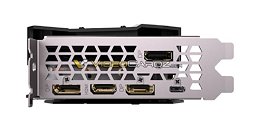Monday, August 20th 2018

USB Type-C with DisplayPort+USB Wiring Could Get a Big Push by NVIDIA
With its GeForce "Maxwell" family, NVIDIA, riding on the multi-monitor fad, began equipping its graphics cards with up to three DisplayPort connectors, besides an HDMI, and optionally, a legacy DVI connector. Prior to that generation, AMD dabbled with equipping its cards with two mini-DisplayPorts, besides two DVI and an HDMI.
With the latest GeForce RTX "Turing" family, NVIDIA could push for the adoption of USB type-C connectors with DisplayPort wiring, and perhaps even USB-PD standards compliance, pushing up to 60 Watts of power from the same port. This USB+DP+Power connector is called VirtuaLink. This could make it easier for VR HMD manufacturers to design newer generations of their devices with a single USB type-C connection for display and audio input form the GPU, USB input from the system, and power. We reckon 60W is plenty of power for a VR HMD.
Source:
VideoCardz
With the latest GeForce RTX "Turing" family, NVIDIA could push for the adoption of USB type-C connectors with DisplayPort wiring, and perhaps even USB-PD standards compliance, pushing up to 60 Watts of power from the same port. This USB+DP+Power connector is called VirtuaLink. This could make it easier for VR HMD manufacturers to design newer generations of their devices with a single USB type-C connection for display and audio input form the GPU, USB input from the system, and power. We reckon 60W is plenty of power for a VR HMD.

18 Comments on USB Type-C with DisplayPort+USB Wiring Could Get a Big Push by NVIDIA
www.tweaktown.com/news/62539/virtuallink-next-gen-vr-over-single-usb-type-cable/index.html
USB-C powered monitors have the same bandwidth issue. There's also a lot of monitors that 27w wouldn't be enough to drive. I don't think USB-C powered monitors were really the intent or NVIDIA would have put at least two on the card. In general, DisplayPort is the better connector for monitors (better signal separation, longer cable lengths, cheaper to manufacture, and locking mechanism) even though it only has minimal power supply. Supplying monitor power via GPU just relocates power supply from a brick/internal to the monitor to the computer's power supply, motherboard, and GPU. VR headsets are about the only scenario where that's a preferable arrangement.
10 years ago, monitors could be connected to a PSU, as they had input and output slots. This lets for better cable managment and an empty slot in the outlet.
Having it power through a single cable would be a dream.
mini connectors are limited up to 60w & regular are up to 100w if they comply with the profiles. cables too.
Slow adoption is probably because very few want to add whats needed to support the added power. Phones adopted it to charge the battery.
I have a very difficult time believing USB-C can handle 100w. Those cables and contacts are tiny. DC produces a lot of waste heat when the conduits are tiny. Seems like an all around bad idea. 20w? Sure.
DVI -?? if a dvi -d what a waste if DVI-I and analog support great . i'll assume another card that you got to support it instead of it supporting you and your needs
Open your PC case and check the cables that handle a much larger current.
USB-C (in 100W mode) is just 5A, so less than on a single Molex cable - really nothing special.
The cable is fairly wide and the contacts are huge. There is a margin for more. :-)